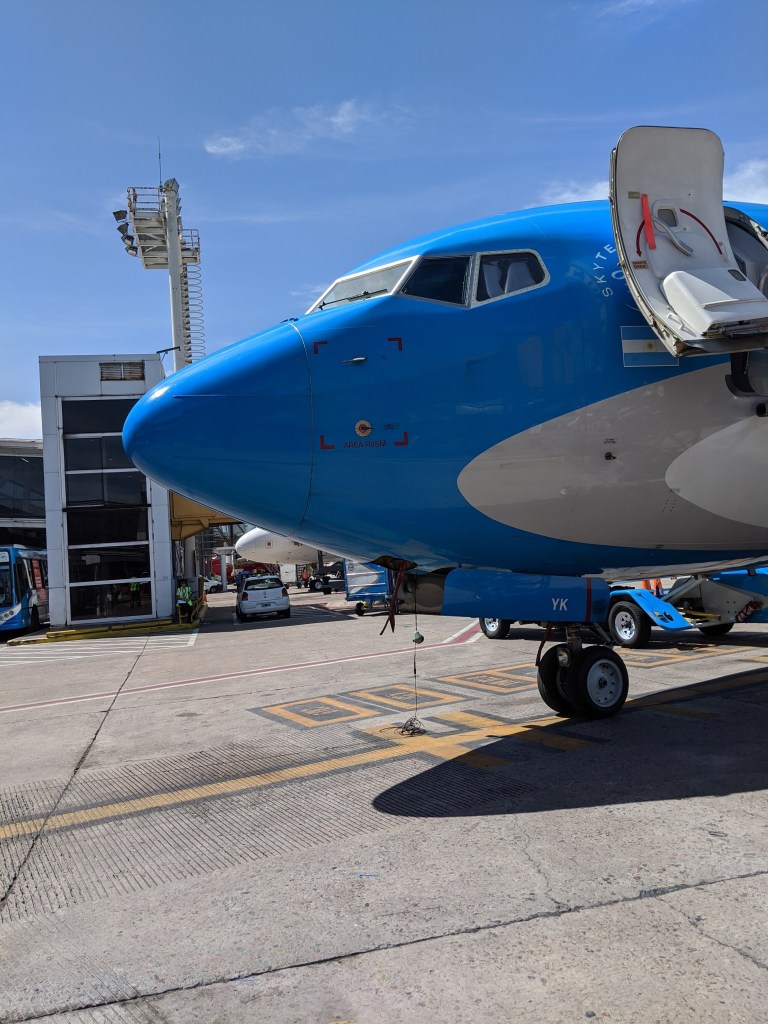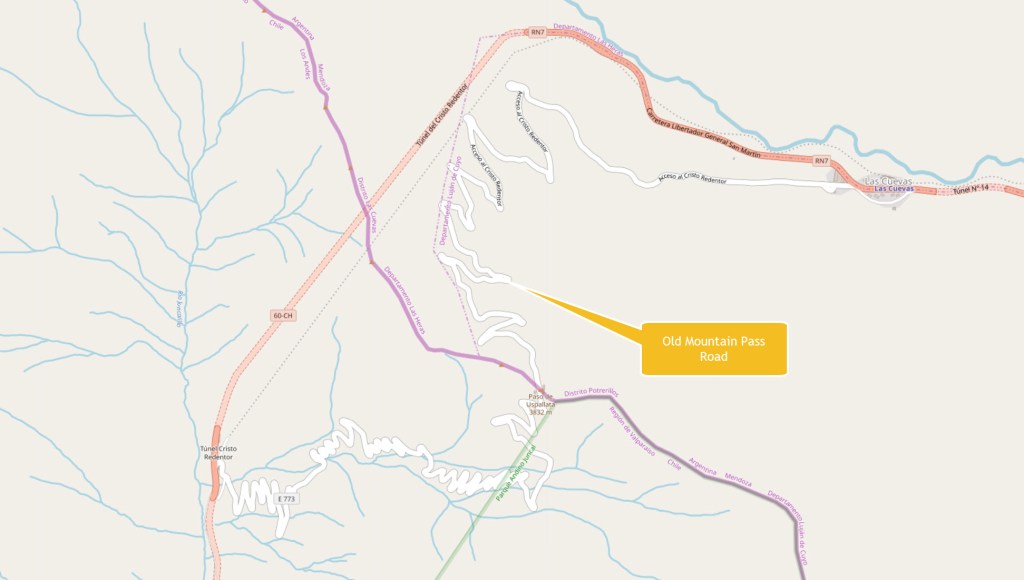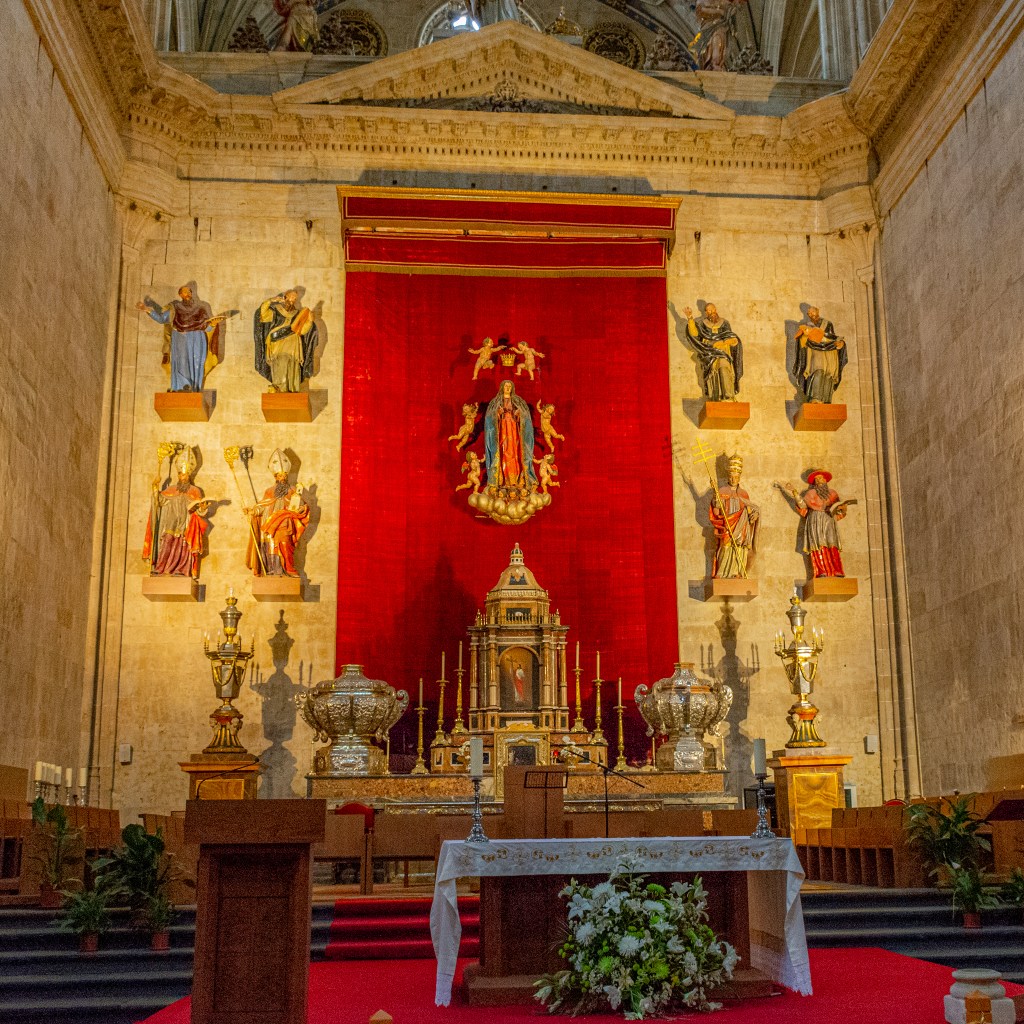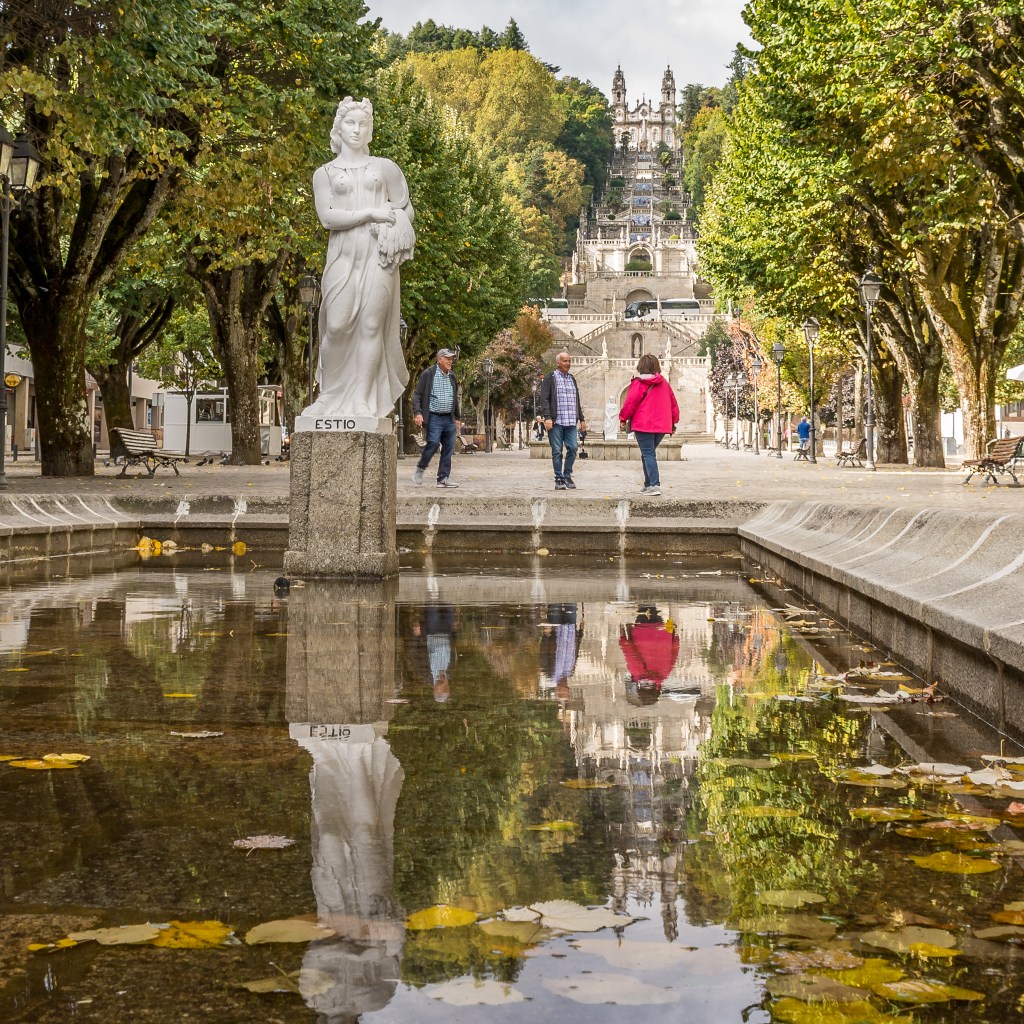Mendoza Argentina – Malbec Wine & Andes Mountains
When we first booked our cruise early last year we decided to do an add-on post-cruise extension and the one we chose was called “Vineyards & Vistas of Mendoza”. This was billed as a 4-day excursion that included round-trip air from Buenos Aires to Mendoza as well as 3-nights in a luxury Mendoza hotel. One day of visiting several vineyards for tours and tastings the second day a scenic drive to the high Andes mountains. Our paperwork also stated that breakfasts were included as well as 2-lunches and 1 dinner. To our surprise we were treated to 3 dinners at 3 amazing Mendoza restaurants which we will discuss more below.
What made this trip so amazing was that we had such a small group, only 6 signed up, and we had two wonderful tour guides, Ailin (Eileen) and Estefan, who stayed with us the whole trip as well as a great driver, Horacio, with a very comfortable Mercedes mini-bus.
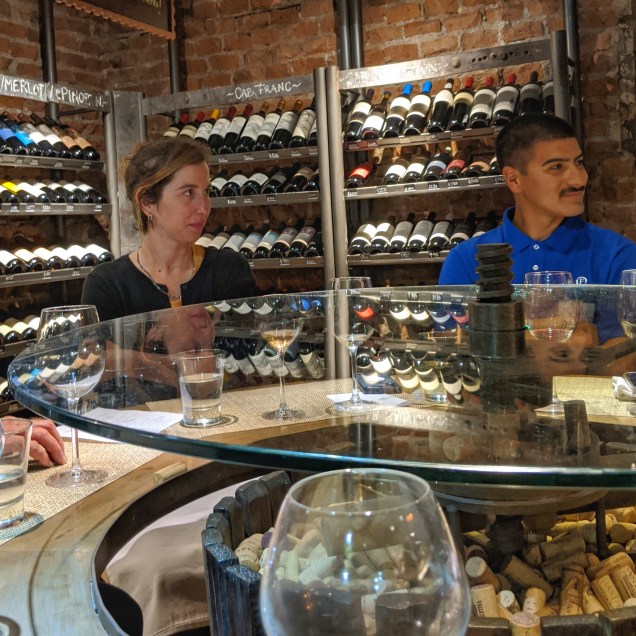
Our guides Ailin and Estefan 
Our driver Horacio (l) with his Mate and our guide Estefan (r). Stopping for coffee and cake in Andes Foothills. 
Our ride.
Our Hotel – The Diplomatic Hotel
The hotel accommodations were very good. The Diplomatic Hotel is rated as a 5-star hotel located in the downtown area of Mendoza, very convenient to restaurants and shopping. The hotel is nicely appointed with a very elegant lobby area. Our room was large and comfortable and we were on the 15th floor with a great view. Every evening at 7:00 PM the hotel offered free wine tasting in the lobby and each night the wines were from a different, local vineyard.
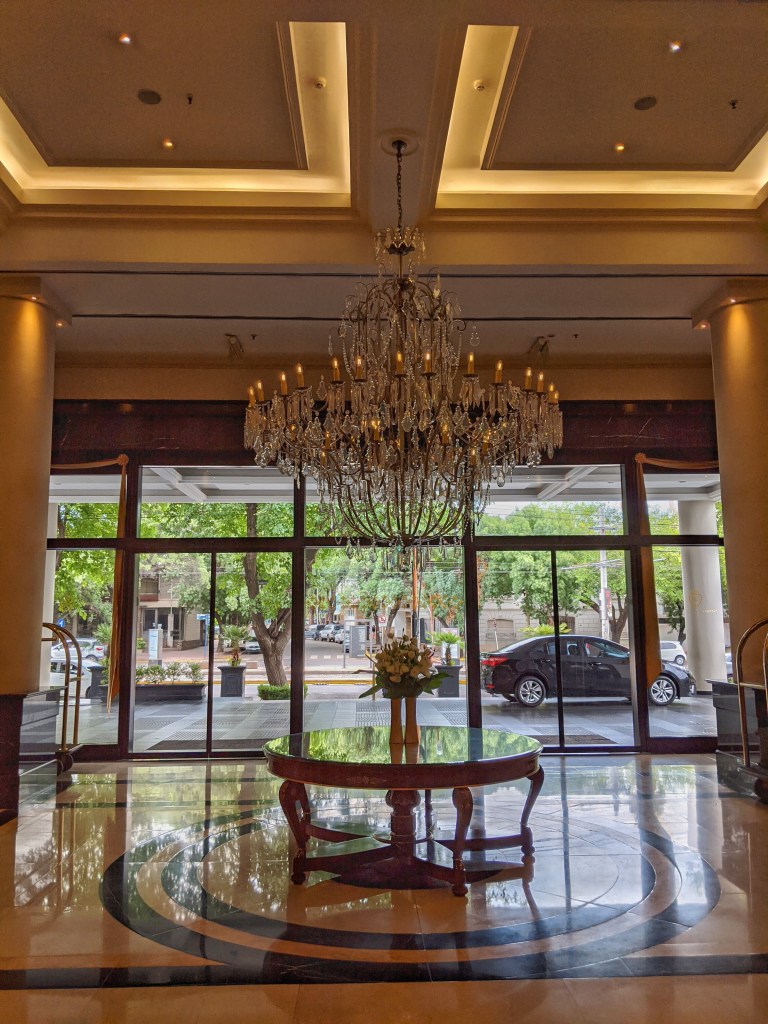
Main entrance 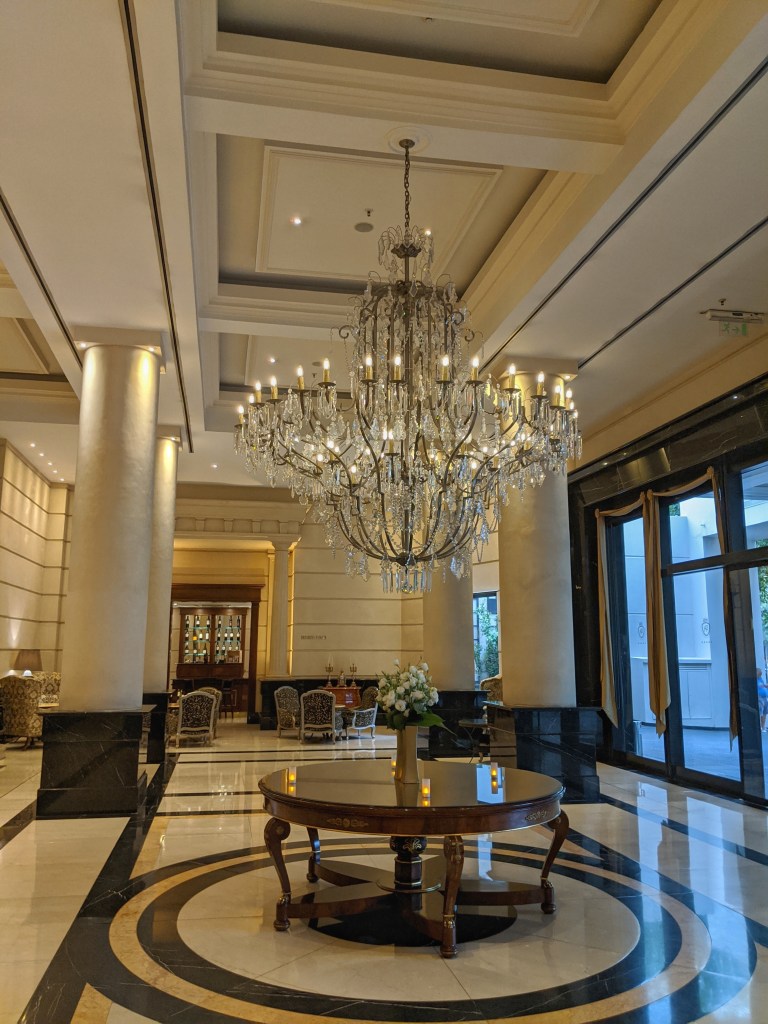
Lobby chandelier 
Lobby furnishing 
Sunrise view from our room 
Marble staircase 
Lobby sitting area
Winery Visits
Our second day in Mendoza was scheduled for three winery tours along with lunch. We drove about 30-minutes outside town where miles and miles of vineyards line the roads. Both our tour guides Ailin and Estefan told us about the history and make-up of the Mendoza wine industry. Our guides are extremely knowledgeable about wine making and wine culture.
Casarena Bodega & Vineyards
Our first vineyard was the Casarena Bodega y Viñedos located about 26km from downtown Mendoza. This was a picturesque vineyard with the grapes about ready for harvest. We noted that all the vines were covered with wire or plastic mesh. We assumed that this was to prevent birds from getting at the grapes, but it was to protect the grapes and vines from hail, apparently Mendoza gets lots of thunderstorms.
Our tasting included Malbec, which was excellent, we also tried Cabernet Franc, a very good red wine as well. The tour of the underground cellars was interesting, they had racks of different vintages (bottles) that they use for quality control. They will occasionally sample the various aged vintages to make sure they are aging properly.

Malbec grape 

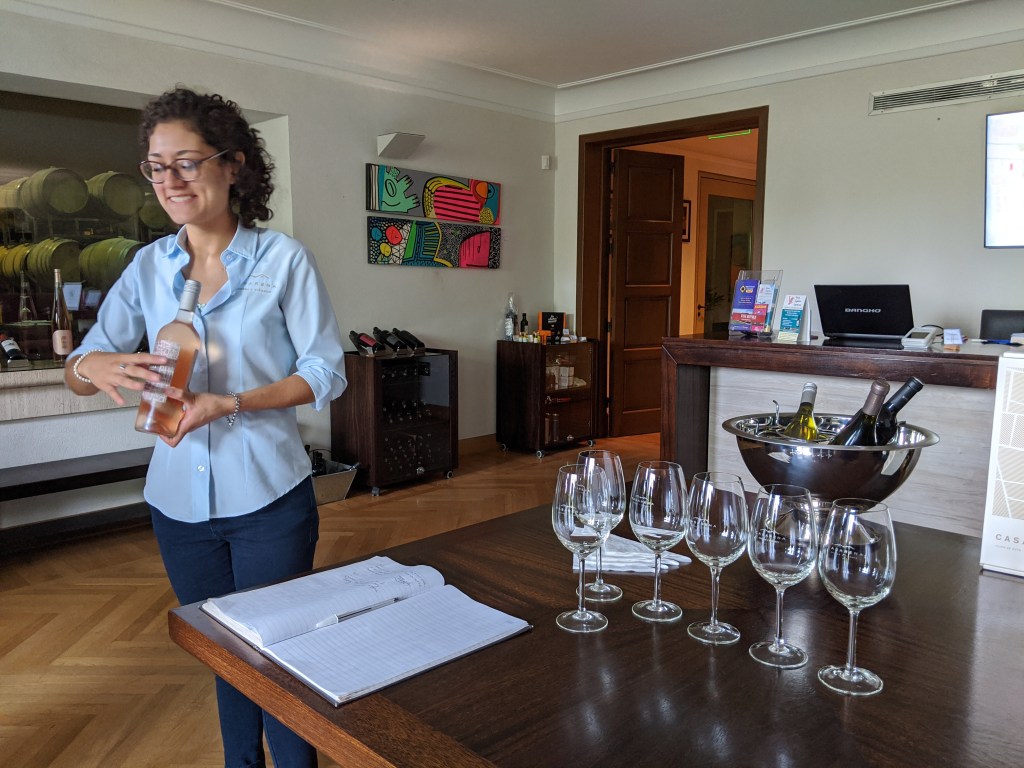


Underground cellars 
Underground cellars. 
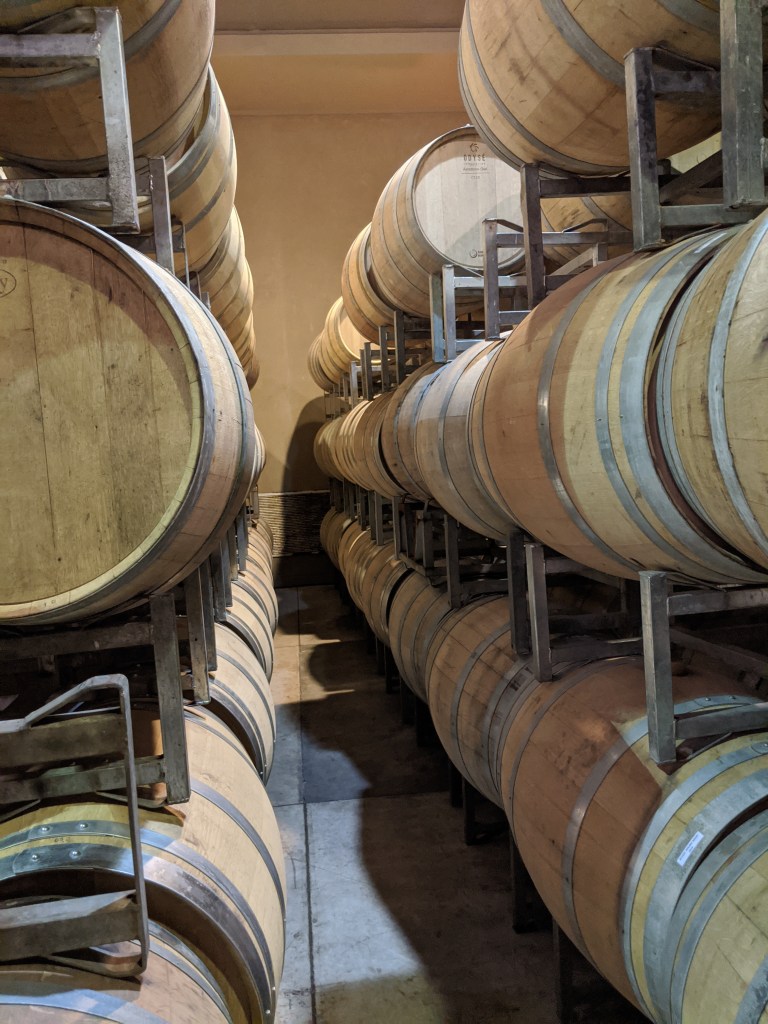
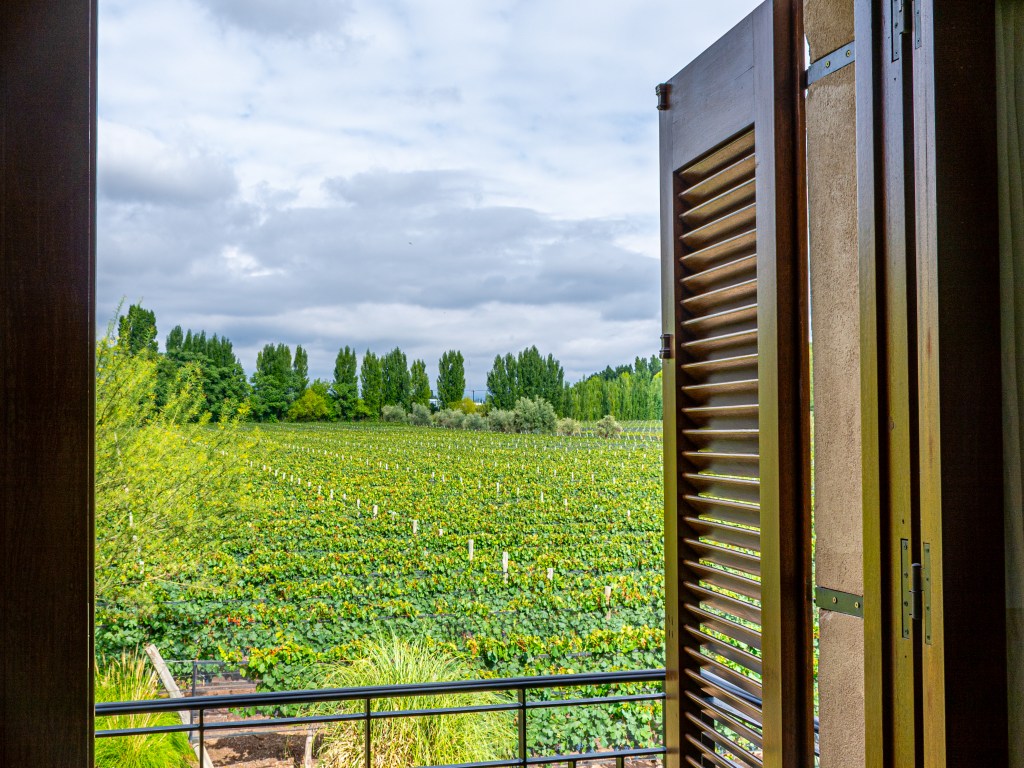
Tasting room overlooking the vineyards.
Caelum Winery
Caelum Winery is s smaller boutique winery in the Mendoza valley, its 145 acres mainly produce the red Malbec and Cabernet Sauvignon varieties, but they also offer a very nice Chardonnay as well as an interesting blush wine. The vineyard also produces pistachios from their small orchard.


Rosado made from 50% Malbec and 50% Cabernet Sauvignon 

Dominio del Plata Winery (Susana Balbo Wines)
Our third and final winery visit was to the Susana Balbo Winery. The winery has a restaurant called Osadía de Crear where we had a lunch that included wine pairings.
Susana Balbo is Argentina’s first women to receive a degree in enology (science and study of wine and wine-making) and has been a pioneering winemaker in Mendoza.


Argentine steak for lunch. 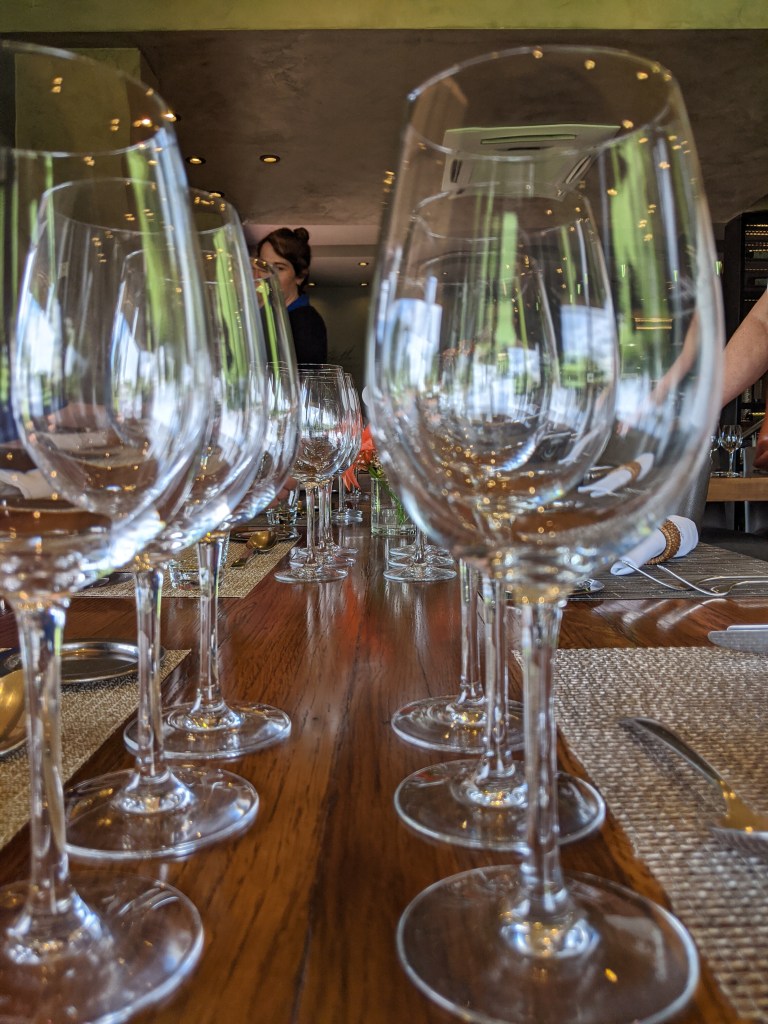
Glasses lined up for the lunch pairings. 
Pear shaped wooded fermentation barrels. 
Egg shaped concrete fermentation tanks. 
Stainless steel fermentation tanks. 
Andes Day Trip
On our second full day in Mendoza we were off at 7:30 AM from the hotel to start the long 3.5 – 4 hour drive. We would travel northwest on Highway 7 (road to Chile) along the Mendoza river valley as it climbed steadily through the foothills of the Andes. Our final destination was to drive up the old Uspallata Pass road to visit the famous Christ the Redeemer of the Andes monument which sits on the Argentine – Chile border at about 12,700-ft above sea level.
We had several stops along the way, the first stop was at a scenic overlook on Lake Potrerillos (man-made lake above Potrerillos hydro-electric dam). Our guides Ailin, Estefan and driver Horacio setup a small table and served us coffee and pastries with the scenic backdrop of Lake Potrerillos and surrounding mountains to enjoy.
A brief technical or “comfort” stop in the small town of Uspallata which is in a wide valley surrounded by larger, more rugged mountains leading to the high Andes.

Mapping out our day trip to the Andes.

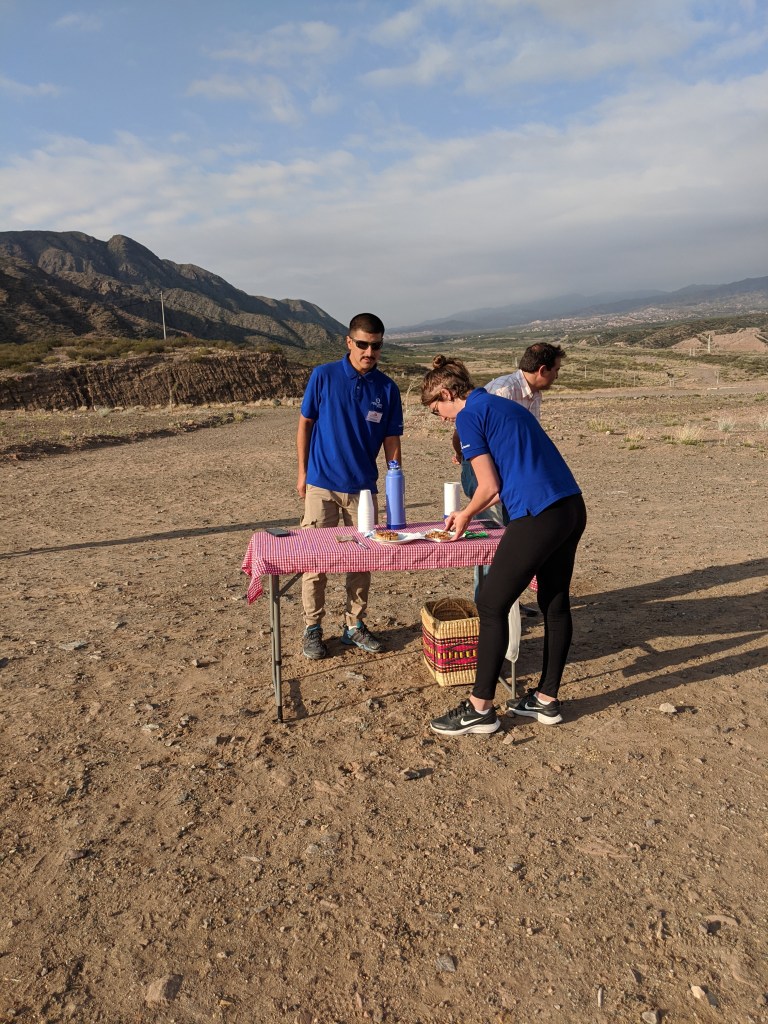
Setting up our coffee break. 
Tasty treats with coffee. 
Morning light and clouds provide a mystical backdrop.
Two additional stops before we reached our final destination. A stop at an observation point where we viewed Mount Aconcagua, at 22,837 ft., the highest mountain in the Americas and actually the highest outside of the Himalayas.
Another stop at Puente del Inca (Inca Bridge), a natural rock formation bridge at a mineral hot spring. The site is a bit touristy with many gift shops. The minerals from the hot springs have created colorful rock formations at the site. There is also an abandoned railroad station as well as ruins of a former hotel at the hot springs (hotel was demolished by an avalanche many years ago). The abandoned railroad station is part of a discontinued rail line that ran from Mendoza to Santiago Chile and much of the rail bed and infrastructure follows the Mendoza river and can be seen from Highway 7.

Mt. Aconcagua 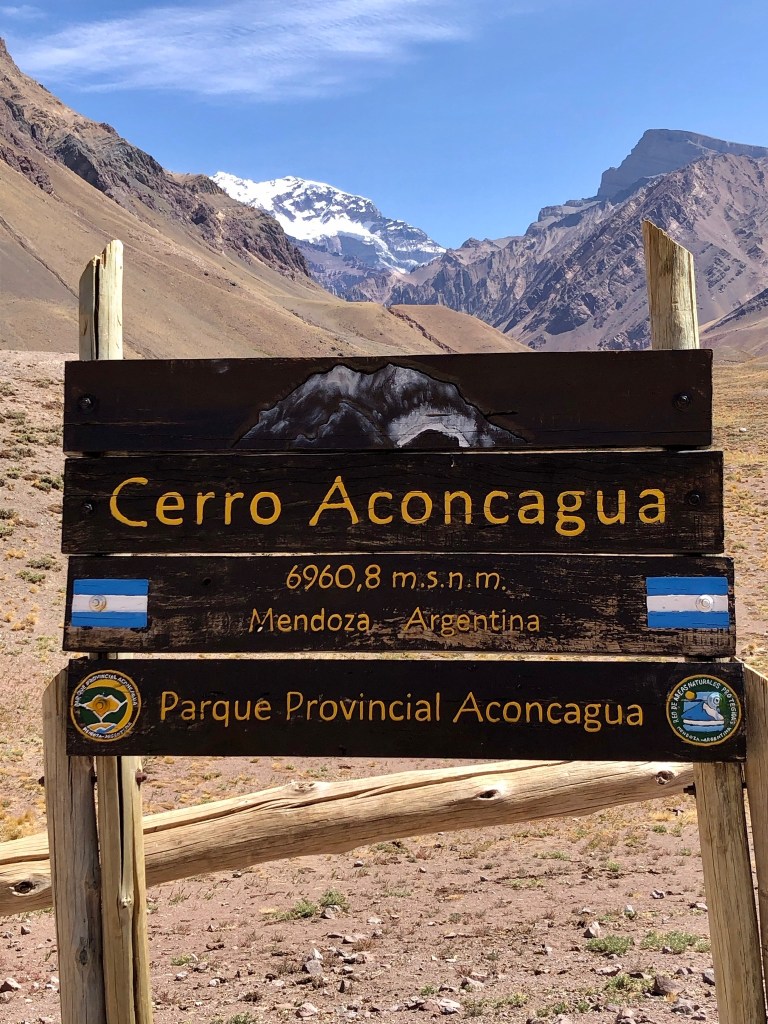

Abandoned railroad station 

Gift shops 
Inca Bridge and mineral deposits.
The drive to the top of Uspallata Pass was quite exciting. The dirt road has many sharp switchback curves as it winds its way up the the top. The road is barely wide enough for two vehicles, so it gets interesting when another car or bus is heading our way.
Our tour guide Estefan narrated the account of Argentina’s patriot, San Martin who led the Army of the Andes up this same pass to defeat Spanish forces in the early 19th Century and establish Argentina’s independence. Estefan is very passionate and knowledgeable about his country’s history and he likened San Martin to George Washington.
At the top we had time to explore, but it was extremely windy and a bit cold, so we huddled into one of the gift shops where Estefan had the vendors give us samples of some local drinks. It seemed both the cold drink and hot drink had some alcohol content, but don’t recall the local name of these drinks.
At this high altitude, we were a bit light headed and uncomfortable, so we didn’t stay too long before we started heading down to the base village where we would have lunch.




Christ of the Andes Monument straddles the border. Argentina on the left, Chile on the right.
We got back down to the valley floor (a mere 7,000 ft above sea level) at the village of Las Cuevas where we had “hiker’s lunch” at Portezuelo del Viento, a hostel for backpackers and mountain climbers. The lunch was home cooked, Kathie had the chicken milanesa and I had the gnocchi. Of course, Malbec was the wine of choice.
Estefan introduced us to the owner, Juan Pablo Sarjanovich, who is a world class mountain climber, having climbed in the Himalayas and elsewhere. He is a guide who takes climbers up to nearby Mt. Aconcagua.
After this long day, we headed back to Mendoza and in the evening would have our farewell dinner.


View from the hostel dining room. 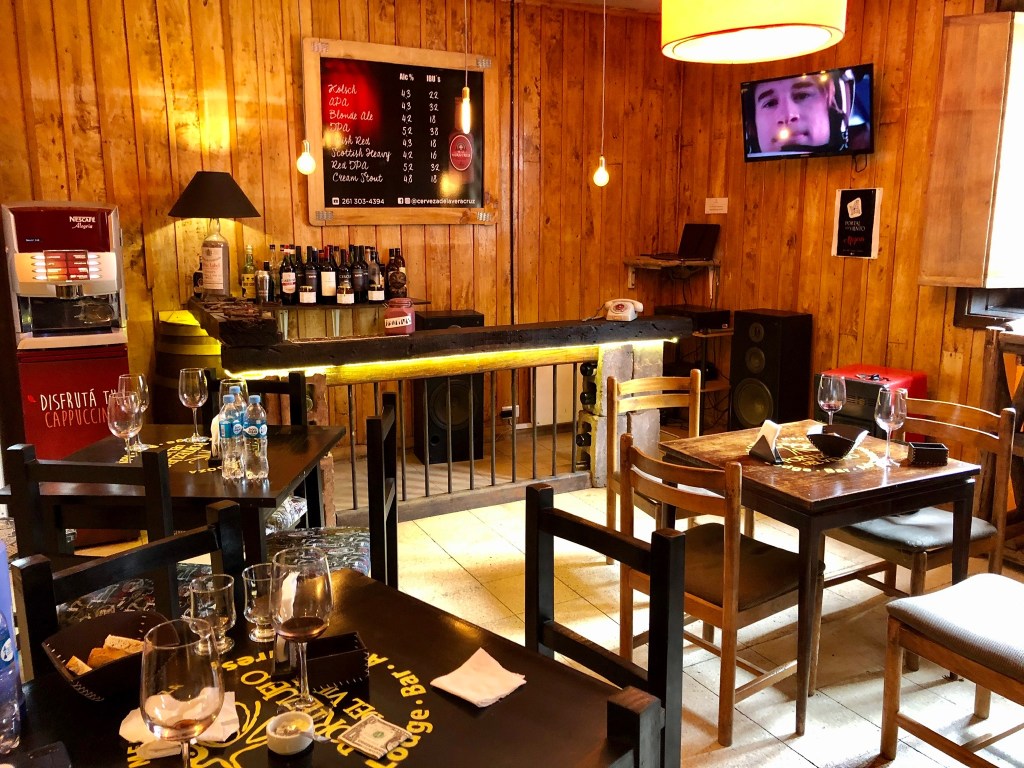
Cozy dining room. 
Restaurants
Our tour itinerary included a group dinner each of the three nights we were in Mendoza. Our tour guides and Viking set up reservations at three premier restaurants of Mendoza.
Maria Antonieta
On our first night in Mendoza our tour guides brought us to one of Mendoza’s best restaurants, Maria Antonieta for our welcome dinner. The restaurant was right next door to the Diplomatic Hotel, so a very quick walk to our table. This restaurant is owned by Chef Vanina Chimeno the wife and partner of Argentina’s most famous chef and restaurateur Francis Mallmann. Some may recognize Chef Mallmann who was featured on season 1 of the Netflix series Chef’s Table.
This restaurant is a small bistro with an open kitchen and apparently it is difficult to get reservations, but thanks to Viking we were able to get a table for eight for our group.
Sitting at the table next to us was a man and woman who had that “celebrity look”. Later our guides told us that the gentleman was “La Mona” a well known Argentine pop star. He and his wife were staying at the Diplomatic Hotel and we later saw lots of fans outside the hotel hoping for a glimpse or autograph.
We had a great meal at Maria Antonieta, most opting for the signature Rib Eye steak accompanied by an excellent Malbec. A great first night in Mendoza!

Josefina Restó
On our second night the group had dinner at Josefina Restó. This restaurant is on Avenue Arístides Villanueva, simply known as Aristides by the locals, and it is Mendoza’s main night life area. Plenty of restaurants and bars make this a lively neighborhood.
Another great choice, this restaurant is a large open space with floor to ceiling windows and we had a window table, taking in all the activity outside. The food was great and again we were served some excellent local wines.
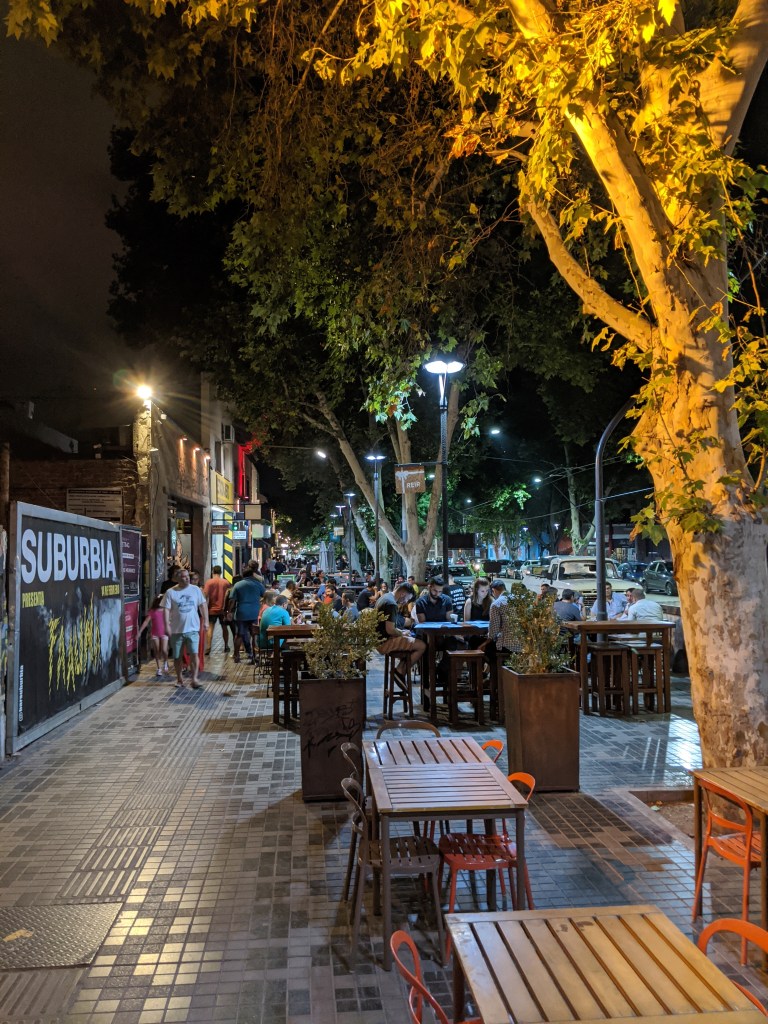
Lively Avenue Arístides Villanueva 
Baked fruits baked in mud with ice cream and caramel crunch. 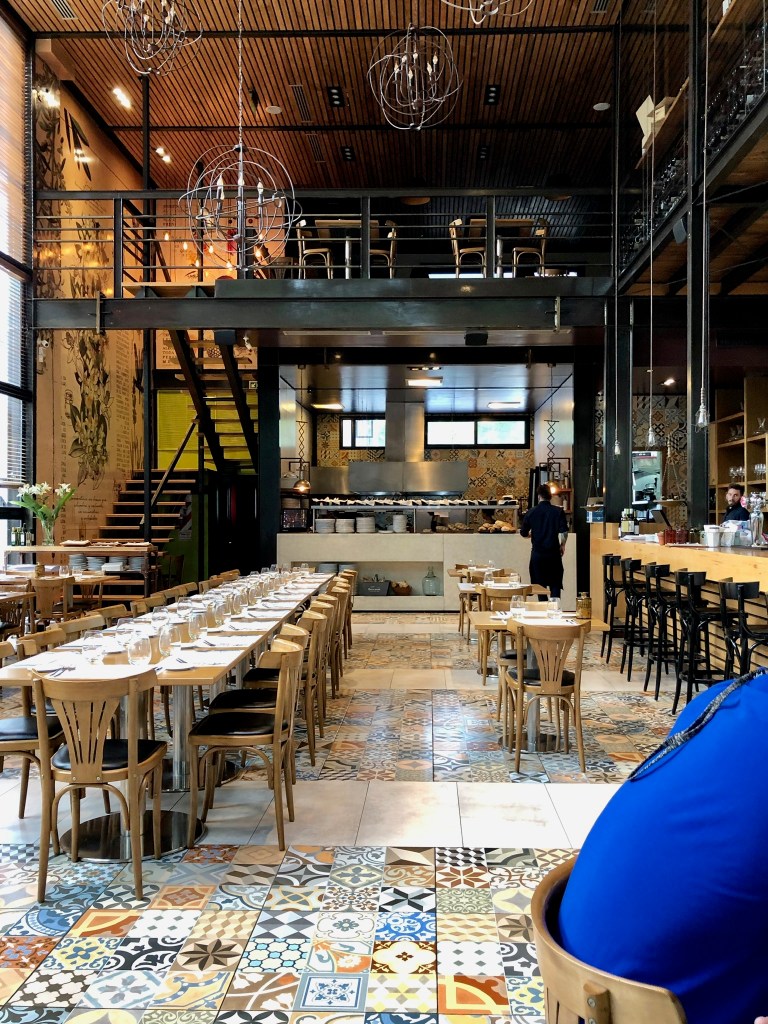
Large open space at Josefina Restó
Azafran Restaurant
On our last night in Mendoza a special farewell dinner was held at Azafran Restaurant, which was around the corner from our hotel. Our tour guides told us that they wanted this last dinner to be special and they did not disappoint.
The restaurant had a special wine cellar which was actually a large room in the front of the restaurant with a large window overlooking their side walk cafe area. The “cellar” had floor to ceiling wine racks and in the center of the room was a large round table where we would be seated for dinner. This room was cooled for the wine, so each chair had an alpaca shawl for those who were cold.
This was a great way to end our Viking cruise and tour. Everyone had an enjoyable time and we stayed very late (we had to get up for a 7am car to the airport). It was a bit sad to say goodbye to our travel companions, our waitress was kind to take a group picture to send us on our way.

Outside view from the wine cellar 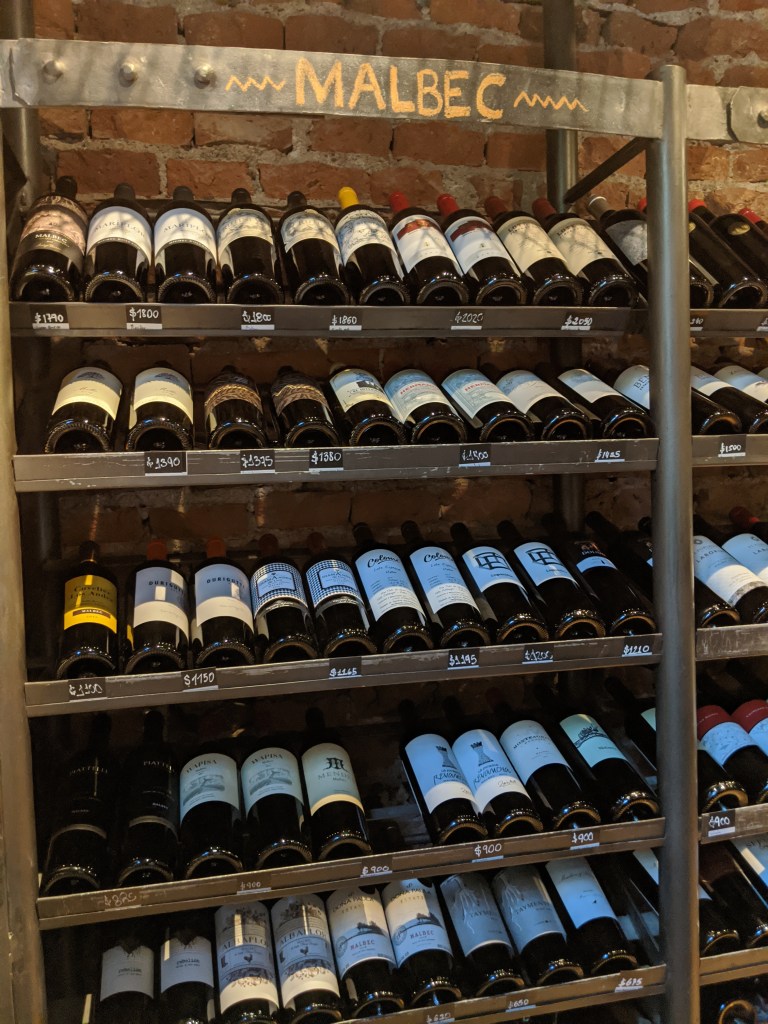
Plenty of Malbec 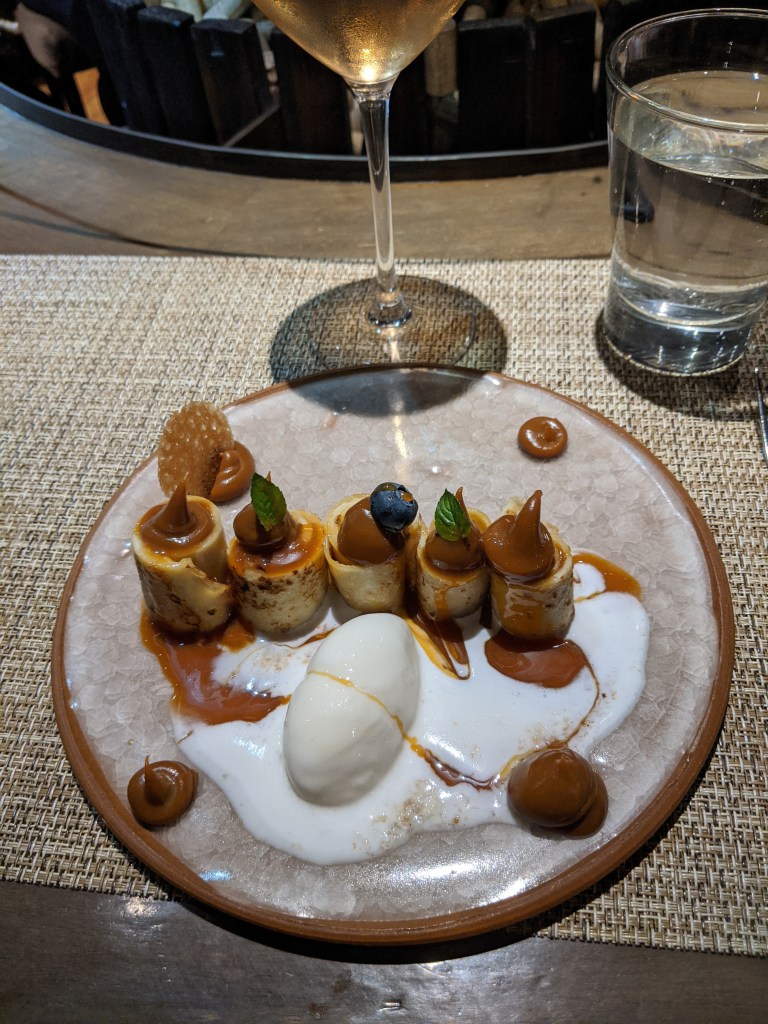
Caramel delight. 
Group photo 

Goodbye Mendoza
After the farewell dinner we said goodbye to the rest of the group and our guide Estafan. While the others were scheduled to fly back to Buenos Aires Int’l airport at noon the next day for their trip home, we were to continue another week on our own with a visit to Uruguay. Our flight was earlier in the morning, so Ailin arranged a car to pick us up at 7am.
Ailin was waiting in the lobby at 7am to make sure we got off OK and we had a young man accompany us to the airport to help us check-in (part of Viking’s transfer service).
The main part of our trip, the Viking Ocean Cruise and post cruise excursion had ended, we were now heading to Montevideo Uruguay for some free style touring. Our flight to Montevideo was on time and the last phase of our long South American adventure was underway. Our next post will be about our Uruguay experiences.
